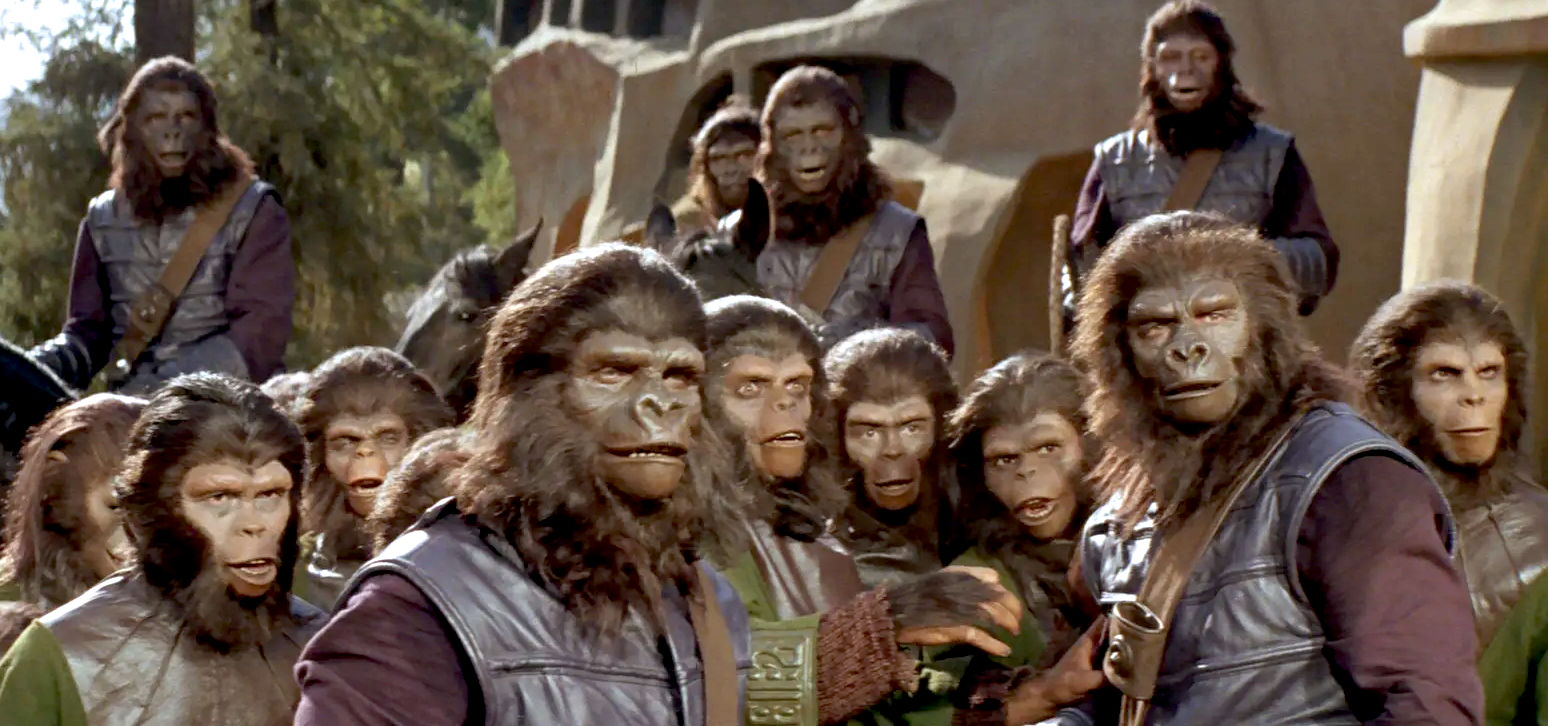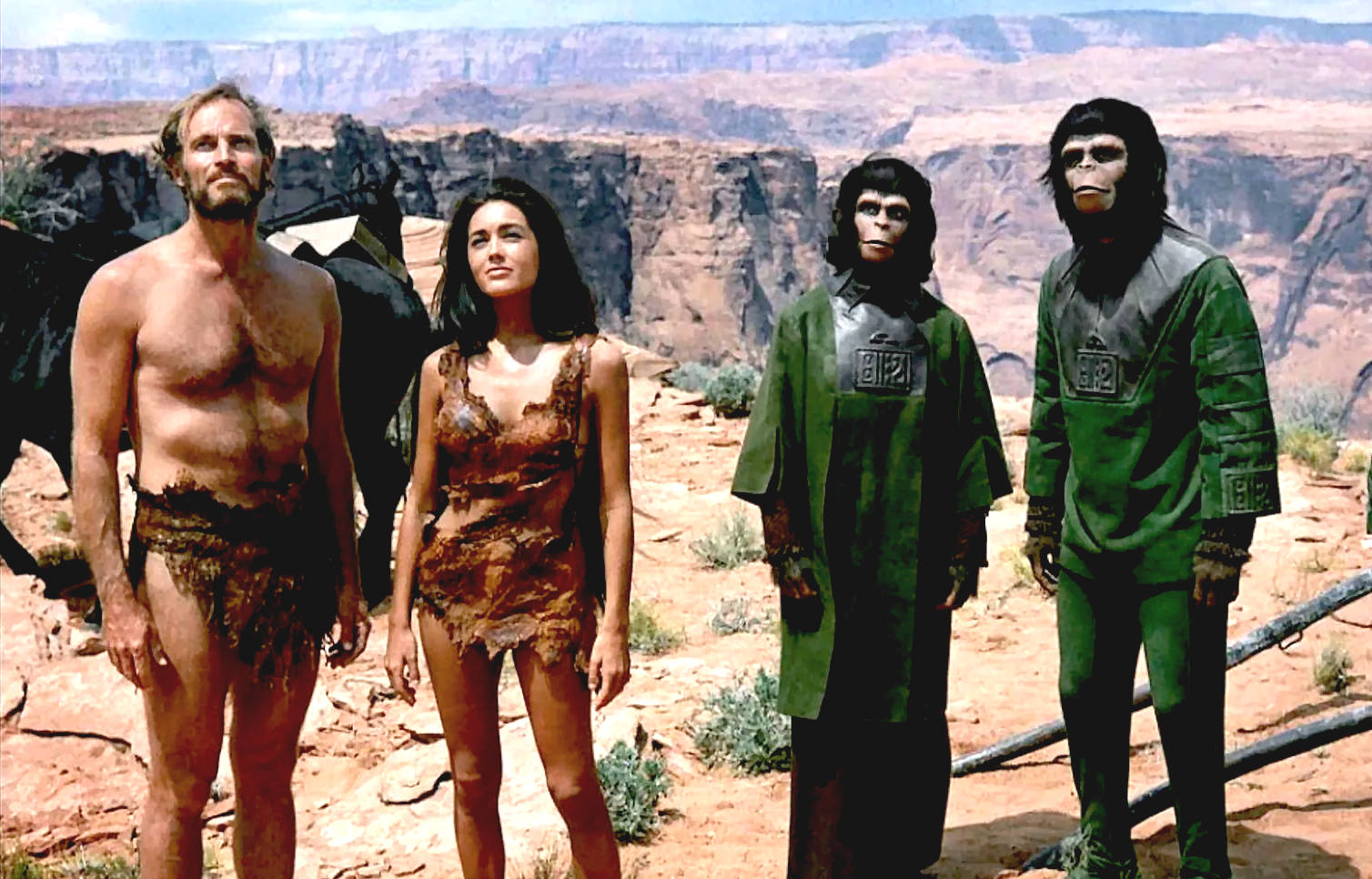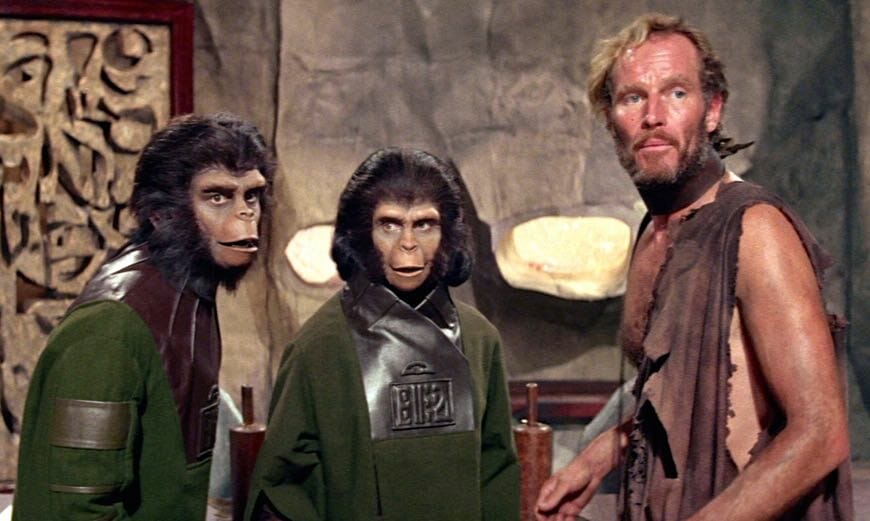
On
Earth, human don't speak until Taylor says: "Get your hands off me
you damn dirty ape."
Planet of the Apes is a 1968 American science fiction film directed by Franklin J. Schaffner from a screenplay by Michael Wilson and Rod Serling, loosely based on the 1963 novel of the same name by Pierre Boulle. The film stars
Charlton Heston, Roddy McDowall, Kim Hunter, Maurice Evans, James Whitmore, James Daly, and Linda Harrison. In the film, an astronaut crew crash-lands on a strange planet in the distant future. Although the planet appears desolate at first, the surviving crew members stumble upon a society in which apes have evolved into creatures with
human-like intelligence and speech. The apes have assumed the role of the dominant species and humans are mute creatures wearing animal skins.
The outline Planet of the Apes script, originally written by Serling, underwent many rewrites before filming eventually began. Directors J. Lee Thompson and Blake Edwards were approached, but the film's producer Arthur P. Jacobs, upon the recommendation of Heston, chose Franklin J. Schaffner to direct the film. Schaffner's changes included an ape society less
advanced - and therefore less expensive to depict - than that of the original novel. Filming took place between May 21 and August 10, 1967, in California, Utah, and Arizona, with desert sequences shot in and around Lake Powell, Glen Canyon National Recreation Area. The film's final "closed" cost was $5.8 million.
Planet of the Apes premiered on February 8, 1968, at the Capitol Theatre in New York City, and was released in the United States on April 3, by
20th Century
Fox. The film was a box-office hit, earning a lifetime domestic gross of $33.3 million. It was groundbreaking for its prosthetic makeup techniques by artist John Chambers and was well received by audiences and critics, being nominated for Best Costume Design and Best Original Score at the 41st Academy Awards, and winning a honorary Academy Award for Chambers. In 2001, Planet of the Apes was selected for preservation in the United States National Film Registry by the Library of Congress as being "culturally, historically, or aesthetically significant".
Planet of the Apes' success launched a franchise, including four sequels, as well as a television series, animated series, comic books, and various merchandising. In particular, Roddy McDowall had a long-running relationship with the franchise, appearing in four of the original five films (he was absent from the second film, Beneath the Planet of the Apes, in which he was replaced by David Watson in the role of Cornelius) and also in the television series. The original film series was followed by Tim Burton's remake of the same name in 2001 and a reboot series, which began with Rise of the Planet of the Apes in 2011.

Charlton
Heston (Taylor), Linda Harisson (Nova), Kim Hunter (Dr Zira) and Roddy
McDowall (Dr Cornelius)
PLOT
Astronauts Taylor, Landon, and Dodge awaken from deep hibernation after a near-light-speed space voyage. Stewart, the lone female crew member, is dead due to a sleep chamber malfunction caused by an air leak. Their spacecraft crashes into a lake on an unknown planet; Taylor's estimate places them in Orion's Bellatrix System, 300 light-years from their home
Solar
System. Before they abandon their sinking vessel, the three survivors read the ship's
chronometer as November 25, 3978 – two thousand and six years after their departure in 1972. However, due to time dilation, the astronauts themselves have aged slightly less than one year.
The men travel through desolate wasteland, coming across eerie scarecrow-like figures and a freshwater lake with lush vegetation. While swimming, the men's clothes are stolen and shredded by primitive mute humans. Soon after, armed
gorillas raid a cornfield where the humans are gathering food. Taylor is shot in the throat as he and the others are captured. Dodge is killed and Landon rendered unconscious in the chaos. Taylor is taken to Ape City. Two chimpanzees, animal psychologist Zira and surgeon Galen, save Taylor's life, though his throat injury renders him temporarily mute.
Taylor is placed with a captive female, whom he later names Nova. He observes an advanced society of talking apes with a strict caste system: gorillas are the military force and laborers; orangutans oversee government and religion; and intellectual chimpanzees are mostly scientists and doctors. The ape society is a theocracy, while the apes consider the primitive humans as vermin to be hunted and either killed outright, enslaved, or used in scientific experiments. Taylor convinces Zira and her fiancé, Cornelius, that he is as intelligent as they are; one way by making a paper airplane. Dr. Zaius, their
orangutan superior, arranges for Taylor to be castrated against Zira's protests. Taylor escapes and finds Dodge's stuffed corpse on display in a museum. He is soon recaptured, in the process revealing that he can speak, which alarms the apes.
A hearing to determine Taylor's origins is convened. Taylor mentions his two comrades, learning that Landon was lobotomized and rendered catatonic. Believing Taylor either is from an unknown human tribe beyond their borders or was the subject of a mad scientist who gave him the power of speech, Zaius privately threatens to castrate and lobotomize Taylor for refusing to reveal his origins. With help from Zira's nephew Lucius, Zira and Cornelius free Taylor and Nova and take them to the Forbidden Zone, a taboo region outside Ape City where Taylor's ship crashed. Ape law has ruled the area out of bounds for centuries. Cornelius and Zira are intent to gather proof of an earlier non-simian civilization – which Cornelius discovered a year earlier – to be cleared of heresy; Taylor focuses on proving he comes from a different planet.
When the group arrives at the cave, Cornelius is intercepted by Zaius and his soldiers. Taylor holds them off by threatening to shoot Zaius, who agrees to enter the cave to disprove their theories. Inside, Cornelius displays remnants of a technologically advanced human society pre-dating simian history. Taylor identifies artifacts such as dentures, eyeglasses, a heart valve...and, to the apes' astonishment, a talking human doll. Zaius admits he has always known about the ancient human civilization. Taylor wants to search for answers. Zaius warns Taylor against finding an answer which he does not like, adding that the now-desolate Forbidden Zone was once a lush paradise. After Taylor and Nova are allowed to leave, Zaius has the cave sealed off to destroy the evidence, while charging Zira, Cornelius, and Lucius with heresy.
Taylor and Nova follow the shoreline on horseback. Eventually, they discover the remnants of the Statue of Liberty, revealing that this supposedly alien planet is actually Earth, long after an apocalyptic nuclear war. Understanding Zaius' earlier warning while Nova looks on in shock, Taylor falls to his knees in despair, condemning humanity for destroying the world.
CAST
Charlton Heston as George Taylor
Roddy McDowall as Dr. Cornelius
Kim Hunter as Dr. Zira
Maurice Evans as Dr. Zaius
James Whitmore as President of the Assembly
James Daly as Dr. Honorius
Linda Harrison as Nova
Robert Gunner as Landon
Lou Wagner as Lucius
Woodrow Parfrey as Dr. Maximus
Jeff Burton as Dodge
Buck Kartalian as Julius
Norman Burton as Hunt Leader
Wright King as Dr. Galen
Paul Lambert as Minister
Dianne Stanley as Stewart
CRITICS
Planet of the Apes was met with critical acclaim and is widely regarded as a classic. It was rated one of the best films of 1968, applauded for its imagination and its commentary on a possible world turned upside down. Pauline Kael called it "one of the most entertaining science-fiction fantasies ever to come out of Hollywood." Roger Ebert of the Chicago Sun-Times gave the film three stars out of four and called it "much better than I expected it to be. It is quickly paced, completely entertaining, and its philosophical pretensions don't get in the way." Renata Adler of The New York Times wrote, "It is no good at all, but fun, at moments, to watch." Arthur D. Murphy of Variety called it "an amazing film." He thought the script "at times digresses into low comedy," but "the totality of the film works very well." Kevin Thomas of the Los Angeles Times wrote, "A triumph of artistry and imagination, it is at once a timely parable and a grand adventure on an epic scale." Richard L. Coe of The Washington Post called it an "amusing and unusually engrossing picture."
As of November 2022, the film has a "Certified Fresh" 87% rating on the review aggregate website Rotten Tomatoes, based on 60 reviews with an average rating of 7.60/10. The website's critical consensus reads, "Planet of the Apes raises thought-provoking questions about our culture without letting social commentary get in the way of the drama and action." In 2008, the film was selected by Empire magazine as one of The 500 Greatest Movies of All Time.
PRODUCTION
Producer Arthur P. Jacobs bought the rights for the Pierre Boulle novel before its publication in 1963. Jacobs pitched the production to many studios, and in late 1964, the project was announced as a Warner Brothers production, with Blake Edwards attached to direct. After Jacobs made a successful debut as a producer doing What a Way to Go! (1964) for 20th Century Fox and begun pre-production of another movie for the studio, Doctor Dolittle, he managed to convince Fox vice-president Richard D. Zanuck to greenlight Planet of the Apes.
One script that came close to being made was written by The Twilight Zone creator Rod Serling, though it was finally rejected for a number of reasons. A prime concern was cost, as the technologically advanced ape society portrayed by Serling's script would have involved expensive sets, props, and special effects. The previously blacklisted screenwriter Michael Wilson was brought in to rewrite Serling's script and, as suggested by director Franklin J. Schaffner, the ape society was made more primitive as a way of reducing costs. Serling's stylized twist ending was retained, and became one of the most famous movie endings of all time. The exact location and state of decay of the Statue of Liberty changed over several storyboards. One version depicted the statue buried up to its nose in the middle of a jungle while another depicted the statue in pieces.
To convince the Fox Studio that a Planet of the Apes film could be made, the producers shot a brief test scene from a Rod Serling draft of the script, using early versions of the ape makeup, on March 8, 1966. Charlton Heston appeared as an early version of Taylor (named Thomas, as he was in the Serling-penned drafts), Edward G. Robinson appeared as Zaius, while two then-unknown Fox contract actors, James Brolin and Linda Harrison, played Cornelius and Zira. Harrison, who was at the time the girlfriend of studio chief Richard D. Zanuck, went on to be cast as Nova. Jacobs had at first considered Ursula Andress, then screen tested Angelique Pettyjohn, and even considered doing an international talent search for the role before Harrison's casting. Robinson wound up not joining the cast due to his declining health.
Michael Wilson's rewrite kept the basic structure of Serling's screenplay but rewrote all the dialogue and set the script in a more primitive society. According to associate producer Mort Abrahams an additional
un-credited writer (his only recollection was that the writer's last name was Kelly) polished the script, rewrote some of the dialogue and included some of the more heavy-handed tongue-in-cheek dialogue ("I never met an ape I didn't like") which wasn't in either Serling or Wilson's drafts. According to Abrahams, some scenes, such as the one where the judges imitate the "see no evil, speak no evil and hear no evil" monkeys, were improvised on the set by director Franklin J. Schaffner and kept in the final film because of the audience reaction during test screenings prior to release. During filming John Chambers, who designed prosthetic make-up in the film, held training sessions at 20th Century-Fox studios, where he mentored other make-up artists of the film.
FILMING
Filming began on May 21, 1967, and wrapped on August 10. Most of the early scenes of a desert-like terrain were shot in northern Arizona near the Grand Canyon, the Colorado River, Lake Powell, Glen Canyon and other locations near Page, Arizona. Most scenes of the ape village, interiors and exteriors, were filmed on the Fox Ranch in Malibu Creek State Park, northwest of Los Angeles, essentially the backlot of 20th Century Fox. The concluding beach scenes were filmed on a stretch of California seacoast between Malibu and Oxnard with cliffs that towered 132 feet (40 m) above the shore. Reaching the beach on foot was virtually impossible, so cast, crew, film equipment, and even horses had to be lowered in by helicopter.
The remains of the Statue of Liberty were shot in a secluded cove on the far eastern end of Westward Beach, between Zuma Beach and Point Dume in Malibu. As noted in the documentary Behind the Planet of the Apes, the special effect shot of the half-buried statue was achieved by seamlessly blending a matte painting with existing cliffs. The shot looking down at Taylor was done from a 70-foot (21 m) scaffold, angled over a 1⁄2-scale papier-mache model of the Statue. The actors in Planet of the Apes were so affected by their roles and wardrobe that, when not shooting, they automatically segregated themselves with the species they were portraying.
At one point, it was decided that Nova was pregnant, and scenes were filmed around the Page locations revealing Nova's pregnancy. In the penultimate drafts of Planet of the Apes, Taylor was killed by the bullet of an ape sniper while Nova, pregnant with Taylor's child, escaped and vanished into the Forbidden Zone. Although Harrison believed it was Heston who rejected the idea of Nova's pregnancy, those scenes were deleted, according to screenwriter Michael Wilson, "at the insistence of a high-echelon Fox executive who found it distasteful. Why? I suppose that, if one defines the mute Nova as merely "humanoid" and not actually human, it would mean that Taylor had committed sodomy." It was also decided that Nova's pregnancy would detract from the film's ending. In any case, all Harrison's scenes with Heston and Hunter in the sequence of Nova's pregnancy were cut. "There's probably a great deal of footage of it somewhere."

COMMENT
Humanity is obsessed with stories about the end of the world because we know all living things die. We’re fascinated with stories about the apocalypse, because they go beyond the death of individuals, and into more unthinkable territory: the death of society, and maybe the planet itself. But most movies and franchises dealing with the subject tend to set their stories long after the cataclysm, in order to focus more securely on humanity’s endurance and determination to survive. Fewer films portray the apocalypse as it’s happening, and most tend to hurry through the key moments.
But not the Planet of the Apes series, consisting of the original 1968 film and its four sequels, the 2001 Tim Burton remake, and the reboot film trilogy, starting with 2011’s Rise of the Planet of the Apes. The franchise began as a post-apocalyptic parable, but in the course of its time-loop/prequel story, it wound up chronicling the fall of humankind and the rise of their replacement species, the apes. Right from the start, the films are meant as social commentary warning humanity about our self-destructive ways, and they touch on a variety of topics that seem increasingly, ominously relevant during this turbulent year. Given how long the franchise has been in play, the Planet of the Apes movies effectively point out how long our species has been dealing with the same issues. Concerns about social justice, racism, xenophobia, and viral infection seem to recur in a never-ending cycle, but they’re often dismissed or ignored, until we encounter a year like 2020.
Planet of the Apes didn’t necessarily begin life as an apocalyptic story. Pierre Boulle’s source novel leans more on social satire — it’s explicitly set on an alien planet, where its ape inhabitants evolved parallel to humanity. Still, Boulle’s experience as a POW during World War II inspired the novel’s action, with the protagonist enduring capture, enslavement, and a lowly position in ape society. That was a great jumping-off point for screenwriters Michael Wilson and Rod Serling, who adapted the novel for the 1968 feature film. That movie sees a crew of near-future astronauts led by George Taylor (Charlton Heston) crash-landing on what they believe is another planet, one where apes evolved as the dominant species, and now subjugate mute, primitive humans.
The infamous final scene of 1968’s Planet of the Apes reveals that Taylor has in fact traveled into Earth’s future and landed back on his home planet. The first sequel, 1970’s Beneath the Planet of the Apes, carries on from there, seeing Taylor and another astronaut, Brent (James Franciscus), battling an invading army of gorillas and an underground human faction who have been mutated by radiation and worship an active nuclear bomb.
FOLLOW ON SERIES
When writers Rick Jaffa and Amanda Silver pitched a new Apes film to 20th Century Fox in the early 2010s, they weren’t interested in the future setting of Boulle’s novel, or in the 1968 film. Instead, they concocted “a great way to reboot Planet of the Apes” by placing it in a modern-day setting and giving it a new relevance to current events. Their 2011 movie Rise of the Planet of the Apes began a trilogy of films that chronicle the fall of man in ways that feel particularly relevant to 2020. Building on themes of animal cruelty and recklessness in pursuit of finding a cure to a seemingly unstoppable disease, the movie sees Dr. Will Rodman (James Franco) attempting to develop a drug that will cure Alzheimer’s. When he tests the drug on apes, they become more intelligent as a side effect.
While Will’s adopted chimp Caesar (Andy Serkis) revolts and leads his fellow apes to freedom, the drug becomes more virulent and dangerous to humans. A pandemic begins that wipes out a majority of Earth’s human population. (Which makes Rise the second pandemic-themed blockbuster of 2011, next to Steven Soderbergh’s Contagion). By the next film, 2014’s Dawn of the Planet of the Apes, the surviving humans and thriving apes are struggling for dominance. Writer Mark Bomback and director Matt Reeves present both sides of the conflict as sympathetically as possible, showing how mistrust, fear, and past injustices make lasting peace an impossibility. This pokes at an uncomfortable truth about how human beings may have no chance for true peace with each other, thanks to the long history of unforgivable atrocities done to other ethnicities, countries, and various groups that are still remembered today.
In Reeves and Bomback’s War for the Planet of the Apes, released in 2017 at the beginning of Trump’s presidency, a megalomaniacal human Colonel, McCullough (Woody Harrelson) forces Caesar and the apes he’s captured and enslaved to build a wall to keep invaders out, though he doesn’t bother explaining the reasoning to the apes. (“Why do they need a wall?” Caesar wonders aloud). Where the prior two films showed how similar the apes and humans were, War points out where they diverge, with the humans becoming increasingly divided, hateful, and fanatical (in moments that deliberately recall Beneath’s mutants), while the apes are more united and noble. The viral pandemic returns once again, mutated this time to rob humans of their speech and higher thinking, passing judgement on the species in a way that’s nearly Biblical. It’s a way of turning them into a version of the easily subjugated people in the original film.
Taken as a whole, the Apes films become a story about cycles of behavior perpetuated throughout time, generation after generation, with species after species making the same mistakes about racism, war, and delusional notions of superiority. The series uses its science-fiction trappings to comment on topics that were as timely 50-odd years ago as they are now. For such old films, their issues seem shockingly relevant now. Perhaps if they weren’t dismissed as kids’ fare, or if they weren’t remembered primarily for odd-looking prosthetic makeup (or in the recent trilogy, uncanny valley-evoking motion-capture animation), more people would pay attention to the warnings each movie gives about human history, and how the issues we’re still battling today can lead to self-destruction. Eventually, if we don’t listen to these urgent, obvious messages about human hatred and violence, we’re all destined to become Taylor, screaming in despair in front of that fallen statue on a desolate beach. Especially today, with Russia's Vladimir Putin hoising the nuclear card, over his way with Ukraine.
CLONING
& QUESTS FOR LIFE FILMS
A-Z
2001:
A Space Odyssey - Stanley Kubrick, Arthur C Clarke
Ben
Hur (Charlton Heston, Jack Hawkins) 1959
Fools
Gold (Matthew McConaughy, Kate Hudson) 2008
Indiana Jones and the
Last Crusade 1989
Jungle
Cruise, (Emily Blunt, Dwayne Johnson) 2021
Jurassic
World Dominion, (Chris Pratt) 2022
La
Amistad (Djimon Hounsou, Matthew McConaughey) 1997
Lara
Croft - Tomb Raider, Pandora's Box 2001
Lara
Croft - Tomb Raider, Cradle of Life 2003
Lara
Croft - Tomb Raider, Himiko 2018
Monty
Python and the Holy Grail 1975
Oblivion
(Tom Cruise, Andria Riseborough) 2013
Planet
of the Apes (Charlton Heston, Roddy McDowall) 1968
Sixth
Day (Arnold Schwarzenegger) 2000
The
Count of Monte Cristo (Jim Caviezel, Guy Pearce) 2002
The
da Vinci Code (Tom Hanks) 2006
The
Fly - (Jeff Goldblum, Geena Davis) 1986
The
Golden Compass (Nicole Kidman, Daniel Craig, Dakota Blue Richards)
2007
The
Greatest Story Ever Told (Charlton Heston) 1965
The
Medicine Man (Sean Connery, Lorraine Bracco) 1992
The
Pope's Exorcist (Russell Crowe, Julius Avery) 2023
The
Ten Commandments (Charlton Heston, Yul Brynner) 1956 Cecile B DeMille
Total
Recall - (Arnold Schwarzenegger, Rachel Ticotin, Sharon Stone) 1990
Uncharted
(Tom Holland, Mark Wahlberg) 2022

The
Cup of Christ is the Holy Grail, that has never been found, in all
searches through the ages.



